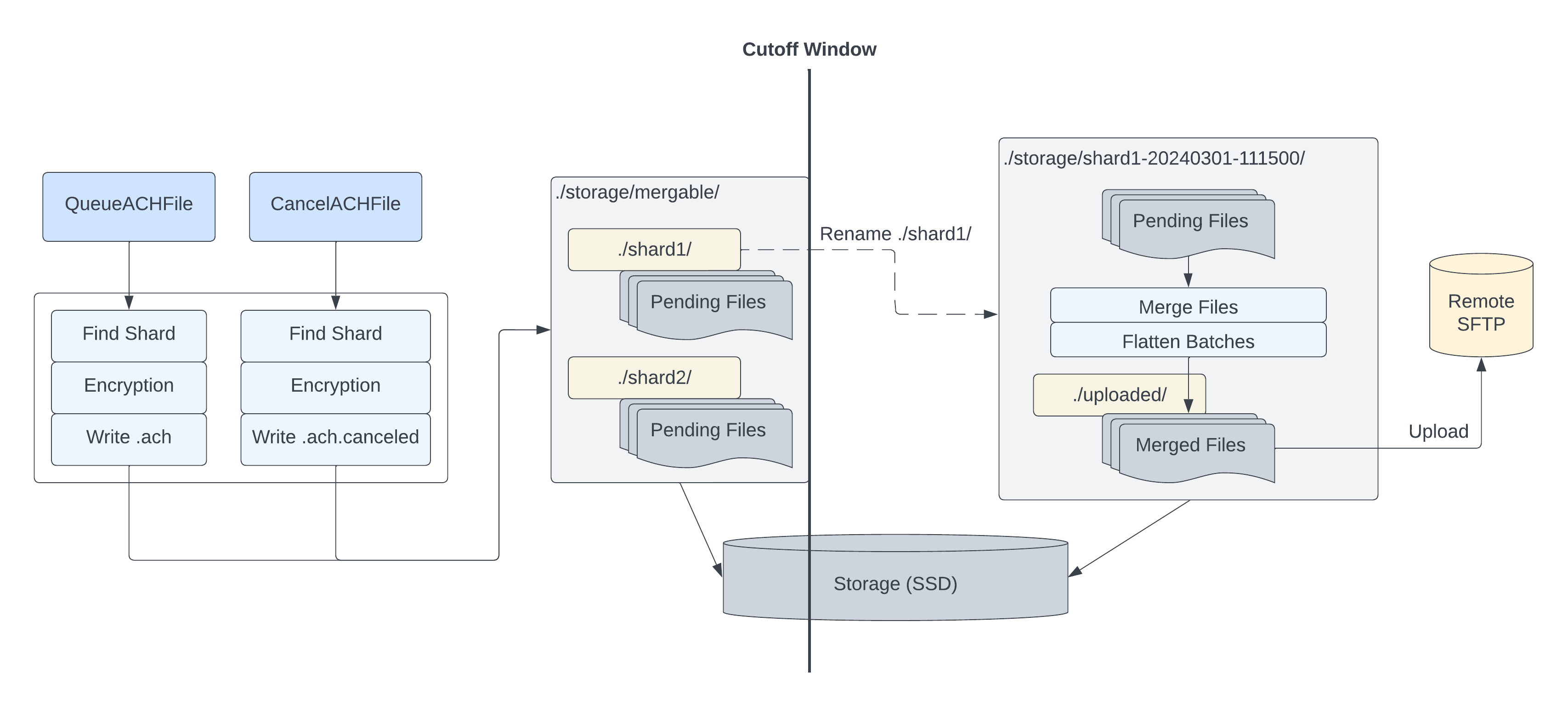Pending Files and Merging
ACHGateway is designed to accept ACH files to batch and merge for upload to a remote FTP/SFTP server. This allows operators to send multiple files over time that can be consolidated into fewer files when uploaded. The design also works without a database being required.
By persisting files to disk ACHGateway is able to survive restarts without losing data or needing to reconsume events. This helps handle higher volumes of files and allows operators access into the pending data. Filenames can be arbitrary strings (e.g. UUID’s) to help identify files or objects. Pending files can be marked as canceled. Merged files optimize network usage and billing costs from your ACH partner.
ACHGateway aims to upload all possible files and accumulates errors for alerting later. If files cannot be merged they’ll be uploaded individually and if a merged file cannot be flattened it’ll be uploaded unflattened. However, if we are unable to cache a file in uploaded/ it won’t be uploaded.
Encryption
ACHGateway supports encrypting pending and merged files in the filesystem used for staging. This uses the moov-io/cryptfs library and can be configured to use AES and encoded in base64 on disk.
Merging
When a shard is triggered ACHGateway will perform a series of steps to merge and upload the pending files.
- Rename the existing directory of pending files from
storage/merging/{shardKey}/to a timestamp version (e.g.storage/merging/{shardKey}-$timestamp/). - Merge pending files (inside
storage/merging/{shardKey}-$timestamp/*.ach) that do not contain a*.canceledfile.- With moov-io/ach’s
MergeFiles(...)function (and optionalach.Conditionsfor max dollar amounts in a file, etc)
- With moov-io/ach’s
- Optionally
FlattenBatches()on files and encrypt file contents (e.g. GPG) - Save file to
uploaded/*.achinside of ourstorage/merging/{shardKey}-$timestamp/directory - Render filename from template, prepare output formatting
ACH transfers are merged (grouped) according to their file header values using ach.MergeFiles. EntryDetail records are not modified as part of the merging process. Merging is done primarily to reduce the fees charged by your ODFI or The Federal Reserve.
Encryption
ACHGateway supports encrypting pending and merged files in the filesystem used for staging. This uses the moov-io/cryptfs library and can be configured to use AES and encoded in base64 on disk.
Options
Merging files accepts a few parameters to tweak uploaded files. This allows for non-standard fields and optimized files. ACHGateway does not modify EntryDetail records, so Trace Numbers can be used to identify records. Multiple files will be created if duplicate Trace Numbers are found within pending files.
The moov-io/ach library supports merge conditions and an ACHGateway shard can be configured to use them as well. An ACHGateway shard can also be configured to “flatten batches” which will consolidate EntryDetail records into fewer batches when their BatchHeader records are identical.
Refer to the Merging section of the Upload config to tweak these values.
Persistence
The recommended way to deploy ACHGateway is where each instance has a unique volume attached. When each instance of ACHGateway has a unique volume attached then ACH operations are shared across N instances and an individual instance would have 1/N’th of the traffic. This deployment model requires that instances consume unique ACH files (e.g. share a kafka consumer group).
